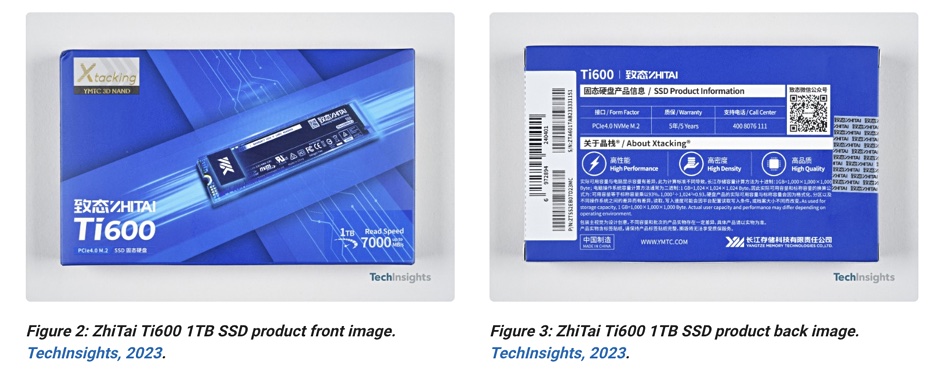China’s YMTC is reportedly shipping a 232-layer 3D NAND chip in QLC (4 bits/cell) format ahead of all other NAND suppliers in spite of US technology sanctions.
Canadian chip analyst TechInsights discovered the YMTC Die in a 1 TB ZhiTai Ti600 SSD. ZhiTai is a consumer SSD brand of YMTC. TechInsights, headquartered in Ottawa, uses reverse engineering and scanning tech to understand new technologies.
The ZhiTai Ti600 was introduced in June and is built on the Xtacking 3.0 architecture. It has up to 2 TB of QLC flash in an M.2 format, an NVMe 2.0 and PCIe gen 4 interconnect, and provides up to 7 GBps read speed and 6 GBps write speed, with an 800 TBW endurance over a five-year warranty. It is priced at $750 on the HKTV mall website.

Xtacking 3.0 is a YMTC NAND architecture in which the 3D NAND die is bonded to a separately fabricated CMOS peripheral circuit logic chip. YMTC revealed an X3-9070 TLC (3 bits/cell) NAND chip using 232-layer NAND at the August 2022 Flash Memory Summit.
The US CHIPS Act is supposed to prevent US suppliers shipping technology to China to prevent companies like YMTC from building 128-layer or greater 3D NAND. It appears to have failed.
TechInsights has revealed a scanned image of the YMTC 232-layer QLC die:

It says this is the first QLC 3D NAND die with more than 200 active word lines that it has seen. The die’s bit density is 19.8 Gb/mm2, the highest density it has seen in a commercially available SSD.
Kioxia/WD (218L), Samsung (236L), SK hynix (238L), and Micron (232L) are sll working on their own 200-plus layer technologies. The Kioxia/WD effort uses separately fabricated control logic and NAND dies bonded together like YMTC’s Xtacking technology.

A Reddit thread revealed a late 2022 TechInsights slide deck on YMTC’s 232L technology. This analyzed a HikSemi CC700 2TB SSD launched in October 2022 that uses TLC 232-layer YMTC NAND. It says there are eight separate NAND dies in the product and an annotated image shows its different size from the QLC die:

Now YMTC has upped the cell bit count to 4. TechInsights said: “Like the innovation revealed by TechInsights in the Huawei Mate 60 Pro’s HiSilicon Kirin 9000s processor (which used SMIC 7nm (N+2) process), evidence is mounting that China’s momentum to overcome trade restrictions and build its own domestic semiconductor supply chain is more successful than expected.”
If TechInsights is right, YMTC is still a force to be reckoned with in 3D NAND fabrication. Research house TrendForce suggested last December that YMTC could exit the NAND market because of the US restrictions. That seems quite unlikely now, and if YMTC can build enough QLC 232-layer chips, US NAND suppliers could have difficulties in the Chinese market.
The Financial Times reports that YMTC is seeking billions of dollars in extra funding because of the cost involved in circumventing US technology export restrictions.







